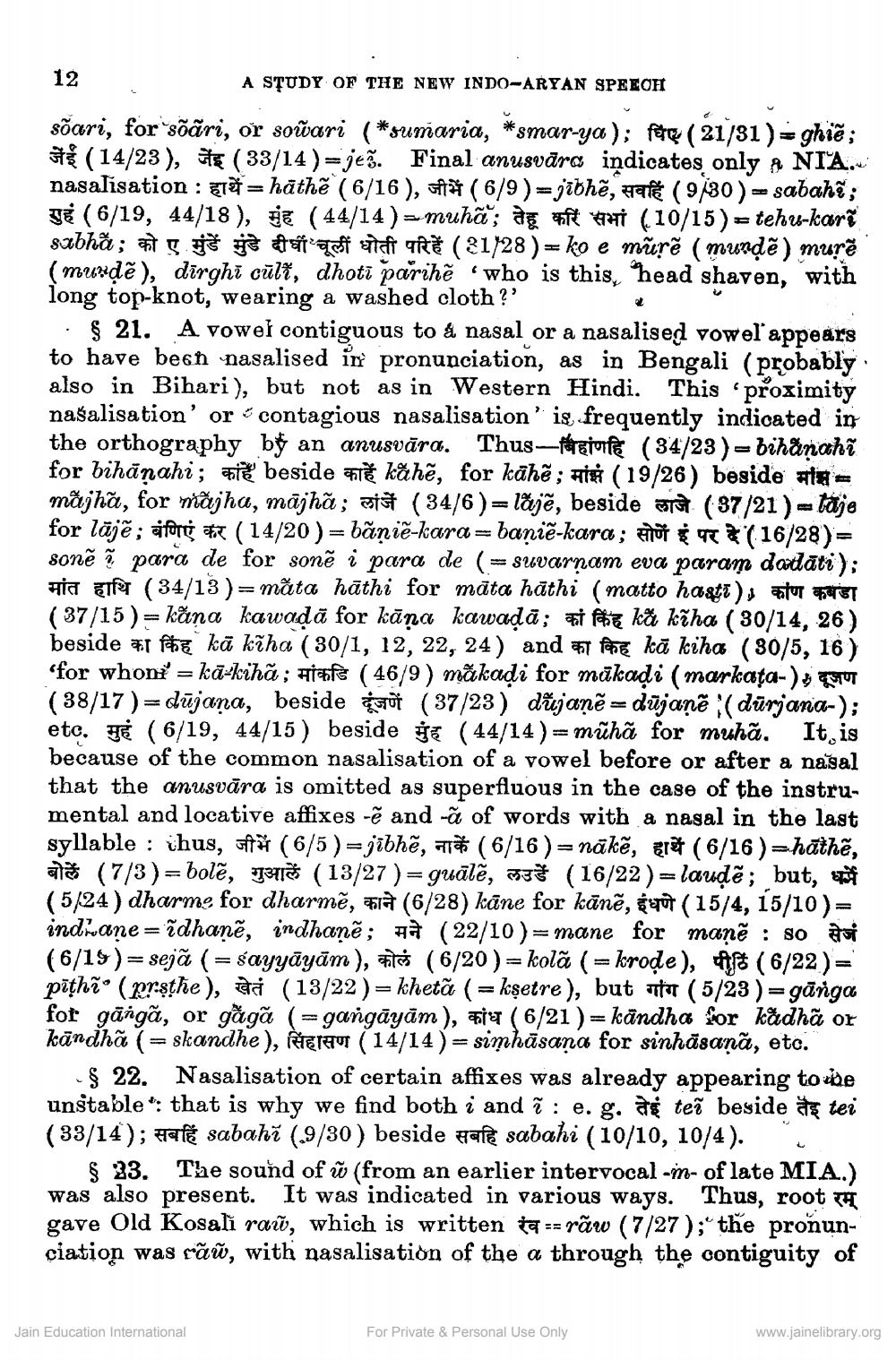________________
12
A STUDY OF THE NEW INDO-ARYAN SPEECH
soari, for soari, or soñari (*sumaria, *smar-ya); fe (21/31) = ghie; (14/23), (33/14)=jes. Final anusvara indicates only a NIA. nasalisation:= hathe (6/16), (6/9)=jibhe, ale (9/30)= sabahĩ; g (6/19, 44/18), (44/14)-muha; aga ai (10/15) tehu-karî sabha; R (21/28) = ko e mure (munde) mure (murḍe), dirghi culi, dhoti parihe who is this, head shaven, with long top-knot, wearing a washed cloth?'
ए
H
§ 21. A vowel contiguous to & nasal or a nasalised vowel appears to have been nasalised in pronunciation, as in Bengali (probably also in Bihari), but not as in Western Hindi. This proximity nasalisation' or contagious nasalisation' is frequently indicated in the orthography by an anusvāra. Thus-train (34/23)= bihanahî for bihānahi; कांहें beside काहें kahe, for kāhē ; मांझं ( 19 / 26 ) beside मझि majha, for majha, mājhã; (34/6)=laje, beside (37/21) - taje for laje; af (14/20) = bãnie-kara banië-kara; (16/28)= sone para de for soně i para de (suvarnam eva param dadāti); if (34/13)= mata hathi for mata hathi (matto hasti), entrepre (37/15)= kana kawaḍa for kāņa kawaḍā; ai ka kiha (30/14, 26) beside ar kā kiha (30/1, 12, 22, 24) and ka kiha (30/5, 16) 'for whonka kiha; if (46/9) makaḍi for makaḍi (markata-) (38/17) dūjana, beside (37/23) dujanë dūjanë (dūrjana-); etc. (6/19, 44/15) beside (44/14)= mühã for muhã. It is because of the common nasalisation of a vowel before or after a nasal that the anusvāra is omitted as superfluous in the case of the instrumental and locative affixes -e and -a of words with a nasal in the last syllable thus, ft (6/5)=jibhẽ, (6/16)= nākẽ, (6/16)=hathe,
(13/27)=guale, (16/22) = laude; but, (6/28) kane for kāne, (15/4, 15/10)= (22/10)= mane for mane: so a (6/19)= seja (= sayyāyām), (6/20) = kola (=kroḍe), (6/22)= pithi (prsthe), (13/22)= kheta (= kṣetre), but (5/23)=gānga for ganga, or gaga (= gangāyām), (6/21) = kāndha for kadha or kandha (= skandhe), (14/14)= simhasana for sinhasana, etc.
a (7/3) = bole, (5/24) dharme for dharme, indrane idhane, indhane;
-
==
§ 22. Nasalisation of certain affixes was already appearing to be unstable: that is why we find both i and e. g. a te besides tei (33/14); sabahi (9/30) beside a sabahi (10/10, 10/4).
Jain Education International
==
§ 23. The sound of w (from an earlier intervocal -m- of late MIA.) was also present. It was indicated in various ways. Thus, root gave Old Kosali raw, which is written raw (7/27); the pronunciation was raw, with nasalisation of the a through the contiguity of
For Private & Personal Use Only
=
امه ها
www.jainelibrary.org




